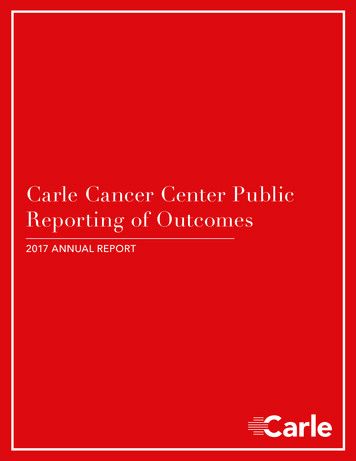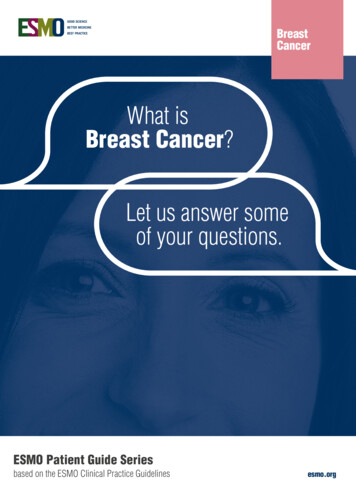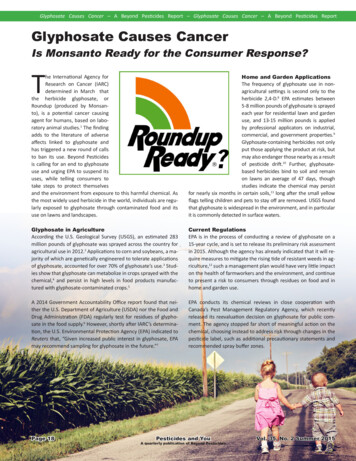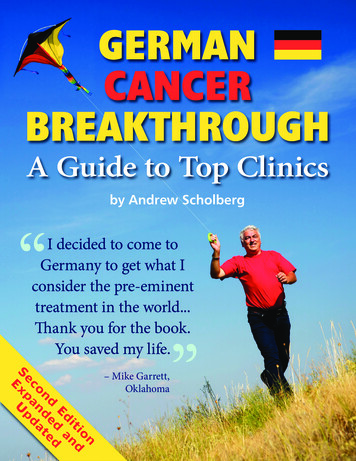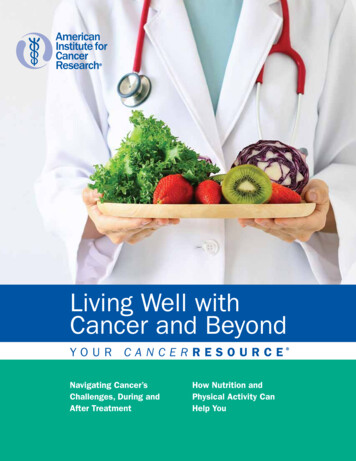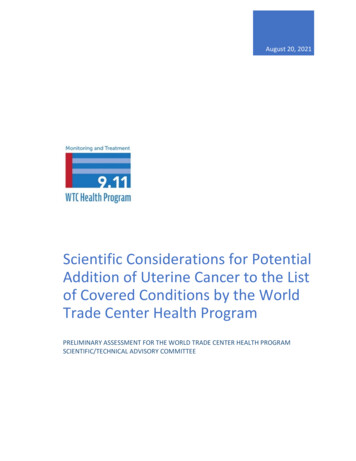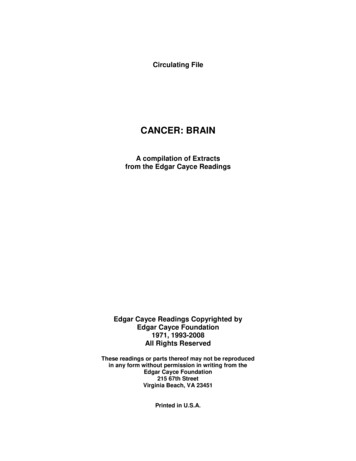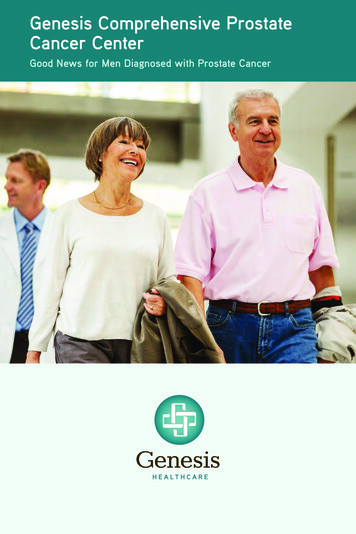
Transcription
Chemicals, Cancer, and YouThere are many risk factors forcancer: age, family history, virusesand bacteria, lifestyle (behaviors),and contact with (touching, eating,drinking, or breathing) harmfulsubstances. More than 100,000chemicals are used by Americans,and about 1,000 new chemicals areintroduced each year. These chemicalsare found in everyday items, such asfoods, personal products, packaging,prescription drugs, and householdand lawn care products. While somechemicals can be harmful, not allcontact with chemicals is dangerous toyour health.This booklet will discuss therelationship between contact withharmful chemicals, cancer, and you.It will explain risk factors (things thatmake you likelier to get cancer), howcancer develops, and how contact with(exposure to) chemicals affects yourbody.Agency for Toxic Substances and Disease RegistryDivision of Health Assessment and ConsultationCS218078-A1
Chemicals, Cancer, and YouSome factors that increase your risk of developingcancer include behaviors such as smoking, heavy alcoholconsumption, on-the-job exposure to chemicals, radiationand sun exposure, and some viruses and bacteria. Whenall these risks are considered together, the role of chemicalexposures in causing cancer is small and, as of now, not veryclear. Scientists know very little about how contact withmost chemicals causes cancer.Substances known to cause cancer are called carcinogens.Coming into contact with a carcinogen does not mean youwill get cancer. It depends on what you were exposed to,how often you were exposed, and how much you wereexposed to, among other things.An early link between cancer and a chemical was foundin the late 1700s. An English physician noted that a largenumber of chimney sweeps had cancer of the scrotum dueto exposure to soot, which contains chemicals known aspolycyclic aromatic hydrocarbons. Since then, many morechemicals have been identified as known or suspectedcauses of cancer. Today, much of what we know aboutchemicals causing cancer in humans we have learned fromworkers exposed at their jobs.Examples of Known Human Carcinogens Asbestos Arsenic Benzene Beryllium Vinyl chlorideExamples of Possible Human Carcinogens Chloroform DDTWhat Is Cancer?The cell is the basic building block of all living things. Allcells normally grow and divide (multiply) to replace oldcells to keep the body healthy. A cell becomes cancerouswhen it grows quickly and uncontrollably. In most cancers,this process leads to the growth of tumors. A tumor is anabnormal growth of tissue resulting from uncontrolled cellgrowth.Tumors are either benign or malignant. Benign tumorsare not cancer. Cells from benign tumors do not spread toother parts of the body. Benign tumors are not usually lifethreatening.Malignant tumors are cancer. Cancer cells can spread toother tissues and organs near the tumor. They can alsospread to other sites in the body through the bloodstreamor lymphatic system. This spreading is called metastasis.People of all ages get cancer, but it is most common inpeople older than 55. One of every three people will getcancer at some point in his/her life.Though we know more about some cancers than others,in most cases we don’t know why or how a normal cellchanges into a cancer cell. We do know that changes occurin a series of steps, which usually takes a long time. The timefrom the first cell change to the time the cancer is detectedis called the latency period.2
Chemicals and CancerUnderstanding which chemicals cause which cancers is oneof our greatest scientific challenges. People are exposed totrace amounts of many chemicals every day. These everydayexposures are usually too small to cause health problems.Exposure to chemicals in the outdoors, at home, and atwork may add to your chances of getting cancer. Certainchemicals, including benzene, beryllium, asbestos, vinylchloride, and arsenic are known human carcinogens,meaning they have been found to cause cancer in humans.A person’s risk of developing cancer depends on how much,how long, how often, and when they are exposed to thesechemicals. When you are exposed is important because asmall exposure in the womb, for example, may be moreserious than a small exposure as an adult. The genes thatyou inherit from your parents also play a role.Some chemicals are known to cause cancer in animals, butthey have not been proven to cause cancer in humans.These chemicals are reasonably anticipated to causecancer in humans and are sometimes called possiblehuman carcinogens. Chloroform, DDT, formaldehyde, andpolychlorinated biphenyls (PCBs) are examples of possiblehuman carcinogens.Getting cancer from a chemical depends on the following: The kind of chemical you were exposed to,How much of the chemical you were in contact with,How long the contact lasted,How often you were exposed,When you were exposed,How you were exposed, andYour general health.3
Exposure at WorkThough everyday exposures to chemicals are usually toolow to cause harmful health problems, exposure in theworkplace can be more serious. Chemical exposures in theworkplace can happen at high levels and over long periodsof time. That is why some jobs require that employeeswear protective clothing and equipment and/or respirators.Companies are supposed to notify their employees of apotential danger to their health. Remember, exposure toharmful substances in the workplace can be very differentfrom exposure in other settings.Cancers Associated with VariousOccupations or Occupational ExposureCancerSubstances or ProcessesLungArsenic, asbestos, cadmium,coke oven fumes, chromiumcompounds, coal gasification,nickel refining, foundrysubstances, radon, soot, tars, oils,silicaBladderAluminum production, rubberindustry, leather industry,4-aminobiphenyl, benzidineNasal cavity andsinusesFormaldehyde, isopropyl alcoholmanufacture, mustard gas, nickelrefining, leather dust, wood dustLarynxAsbestos, isopropyl alcohol,mustard gasPharynxFormaldehyde, mustard gasMesotheliomaAsbestosLymphatic andhematopoieticBenzene, ethylene oxide,herbicides, x-radiation systemSkinArsenic, coal tars, mineral oils,sunlightSoft-tissue sarcomaChlorophenols, chlorophenoxylherbicidesLiverArsenic, vinyl chlorideLipSunlightSources: American Cancer Society Fact Sheet “Occupation and Cancer”;International Agency for Research on Cancer.4
How Chemical Exposure Affects the BodyThe human body has defenses to guard against all sorts ofharmful exposures, including those that may lead to cancer.When something enters your body, it often goes through aprocess that allows the body to more easily use or get rid ofit. This process is called metabolism. Depending on how achemical is processed, or metabolized, in your body, threetypes of carcinogens exist: Chemicals that can cause cancer (direct acting carcinogens), Chemicals that do not cause cancer unless they are changedwhen they are metabolized (procarcinogens), and Chemicals that do not cause cancer by themselves but canact with another chemical to cause cancer (cocarcinogens).Damage to DNA in cells can lead to cancer. However, cellscan often repair DNA damage. If the damage is extreme,the cells may die. Unrepaired DNA damage can lead tomutations, or changes, in genes, and mutations in certaingenes can cause cancer. You can also inherit mutations.Because cancer has a long latency period, determiningwhich exposure, if any, may have led to a mutation isdifficult. Therefore we know very little about specific causesof cancers.How Cells Respond to Chemical Injuries5
Cancer ClustersBecause many cancers are common diseases, they occurquite often in communities. We expect to find several casesof cancer in any given neighborhood or workplace. Becausemost cancers are tracked in national databases, we havea good idea of how many cases to expect in a certain areaover a certain amount of time. However, multiple cases ofcancer in a neighborhood can cause a great deal of concernto residents. People may suspect there is a cancer clusterin their community if several people have cancer. They mayalso suspect something in the environment is the cause.A cancer cluster is when more people within a specificgeographic area have the same type of cancer or relatedcancers than would normally be expected over a certaintime period. However, what appears to be a cluster mayactually reflect the expected number of cancer cases withinthe group or area, or it may be due to chance alone. Clustersmay be suspected if the cancer found is normally rare.For example, mesothelioma is found only in people whohave been exposed to asbestos; therefore, many cases ofmesothelioma were found in communities with asbestosexposure.Cancer clusters are rare, especially those that are linked toan environmental exposure. When a group of cancers islinked to an environmental exposure, it is usually because ofthe conditions below: Many more cases than expected of one specific type ofcancer or related cancers have been found. The cancer is found in an age group in which it is notusually found. The type of cancer is rare. Scientific evidence supports the link between thechemical in question and cancer.Identifying just how much of a cancer-causing substancea community has been exposed to is challenging. Forexample, many hazardous waste sites contain more thanone chemical, which makes relating health outcomes to asingle chemical exposure difficult.Remember that not all chemicals are harmful. Also, justbecause a chemical is in the environment near where youlive or work does not mean that it has entered your body.To learn more about cancer clusters, environmental healthconcerns, and toxic chemicals where you live or work, goto clusters/.6
Risk Factors for CancerMore than 200 types of cancer have been identified. Manyrisk factors—such as age, genetics, or lifestyle choices—canadd to your chance of getting cancer. Cancer is usually notcaused by only one risk factor but by several of them. Themore risk factors you have, the higher your risk of gettingcancer.The most important risk factors are Age: Although people of all ages can get cancer, olderpeople are at greater risk. Genetics: Your family history may put you at risk forcancer. If you or someone in your family had a certaintype of cancer, you may be more at risk for that typeof cancer. Genetics play a large role for many cancers,such as breast cancer and colon cancer. Behaviors: Tobacco use and exposure to the sun orother sources of UV radiation are risk factors for cancer.Other lifestyle choices that might affect your chancesof getting cancer include a poor diet, lack of exercise, orheavy drinking. Viruses or bacteria: Some cancers are caused by a virusor bacteria. Some viruses linked to cancer are thehuman papillomavirus (HPV), which causes cervicalcancer; hepatitis B and C viruses, which can cause livercancer; and the Epstein-Barr virus, which may cause atype of lymphoma. Also, the H. pylori bacterium cancause gastric cancer. Exposure to chemicals: As we have discussed, beingexposed to chemicals may also be a risk factor.7
Behavioral Risk FactorsThe personal choices you make about the way you live candecrease your risk of getting cancer. These include avoidingtobacco use and exposure to secondhand smoke, limitingalcohol consumption, limiting your exposure to sunlightand tanning beds, protecting yourself from viruses spreadthrough sexual contact, maintaining a healthy body weight,and exercising regularly.AlcoholTobaccoCertain medical tests, such as certain types of imaging scans,can increase your risk of cancer. Hormones and hormonerelated drugs, such as menopausal hormone therapy, mayincrease the risk of breast or uterine cancer in women. Evensome treatments used to fight cancer, including drugs andradiation, have been shown to increase the patient’s chanceof a second occurrence of cancer. Talk to your doctor aboutthe risks and benefits of medical tests and treatments.Thirty percent of all cancers are caused by smoking orchewing tobacco. Cigarette, cigar, and pipe smoking cancause cancers of the lung, mouth, throat, larynx (voice box),esophagus, pancreas, kidney, bladder, stomach, and cervix,as well as acute myeloid leukemia. You should also avoidexposure to secondhand smoke, which causes lung cancerin nonsmoking adults and may increase the risk of othercancers in adults and children.Diet & ExerciseMaintain a healthy body weight and live an active lifestyle.Obesity is associated with an increased risk of cancers of thebreast, colon, kidney, and esophagus. Physical activity mayalso lower your risk for some cancers, including cancers ofthe colon and breast. See http://www.cdc.gov/nccdphp/dnpao/index.html to learn more about nutrition, physicalactivity, and obesity.Sexual BehaviorCervical, vaginal, and other genital cancers are caused bycertain types of HPV. Genital HPV spreads through sexualcontact, but condoms may reduce your risk of gettingHPV. Vaccines can prevent infections with some but not allcancer-causing HPV types.If you overuse alcohol, you may be putting yourself at riskfor cancer. Long-term alcohol misuse is associated withcancers of the mouth, throat, esophagus, liver, colon, andbreast.Medical Tests and TreatmentsExposure at WorkJobs that put workers at high risk for cancer include uraniumminers, asbestos workers, shipbuilders, certain factory andchemical plant workers, and workers in nuclear industries.Workers can also bring home contamination on theirclothing, shoes, or skin, which can potentially put otherswho share a home or car at risk. Visit http://www.cdc.gov/niosh/ for more information on workplace safety.Pollution & Exposure to ChemicalsExposure to some chemicals and hazardous substances canincrease the risk of cancer. A few well-known carcinogens areasbestos, nickel, cadmium, radon, vinyl chloride, benzidene,and benzene. These carcinogens may act alone or withanother carcinogen to increase your risk. For example,asbestos workers who also smoke have a higher risk of lungcancer. Visit http://www.atsdr.cdc.gov/ for more informationon specific chemicals and your health.8
Finding CancerMore people are surviving cancer because of early detectionand prompt and more effective treatment. Screening meanschecking your body for cancer before you have symptoms.Getting screening tests regularly may find some breast,cervical, and colorectal cancers early, when treatment maywork best.Tools for finding or diagnosing cancer include Biopsy—a doctor removes tissue, which is looked atunder a microscope; Ultrasound—the use of reflected high-frequency soundwaves to examine tissues of the body; X-ray—producing an image by passing x-rays throughthe body; Computed tomography (CT)—the use of x-rays toproduce a cross-sectional picture of body parts; and Magnetic resonance imaging (MRI)—the use ofmagnetic fields and radio waves to show changes insoft tissues without the use of x-rays.Ultrasound, X-ray, CT, and MRI are all painless andnoninvasive; however, having too many CTs or x-rays canincrease your risk of developing cancer because they exposeyou to radiation. In most cases the benefits outweigh therisks.Mammograms are an example of how X-rays can be used todetect cancer. Other tools for finding and diagnosing canceror abnormal cells that may become cancer include Pap tests,which look for abnormal cervical cells; HPV DNA tests, whichlook for DNA from cancer-causing HPV types in cervical cells;fecal occult blood tests (FOBT), which check for blood in thestool; sigmoidoscopy, which examines the lower colon; andcolonoscopy, which examines the entire colon.Some people choose to do self-exams, such as feelingaround their breasts or testicles for new lumps or lookingover their skin. Talk to your doctor if you notice anythingunusual.9
Cancer and ChildrenWhy a child develops cancer is especially difficult tounderstand and accept. The most common cancers inchildren are leukemia, brain tumors, and lymphomas. Nearly1 in every 450 children will be diagnosed with cancer beforethe age of 15 years.The cause of most childhood cancers is unknown. Unlikecancers found in adults, childhood cancers are usuallynot related to lifestyle risk factors. Genetic predisposition(family history), radiation exposure, viruses and diseases,prenatal health problems, and chemical exposure are someof the factors linked to childhood cancers. Some scientistsbelieve that mutated cells in a child’s rapidly growing bodydivide before the cells can repair their DNA. This maycontribute to the development of childhood cancer.Finding Cancer in ChildrenCancers in children are often hard to find. Parents shouldtake their children to the doctor regularly and be alert toany changes in their health and energy levels, especiallychanges that last for a long time. Telling your doctor aboutany unusual signs or symptoms is important.Some unusual signs or symptoms are New lumps or swelling;Unexplained paleness;Loss of energy;Long-lasting pain or limping;Long-lasting, unexplained fever or sickness;Frequent headaches, often with vomiting;Sudden eye or eyesight changes; andRapid extreme weight loss.10
RecommendationsThough we do not fully understand why one person getscancer and another doesn’t, we do know that you can takesteps to reduce your risk or find cancers early. Protect yourself from the sun’s rays, especially if youburn easily. Use sunscreen and wear protectiveclothing. Maintain a healthy body weight and stay active. Don’t use tobacco and avoid smoke from others. Go to a doctor or health professional regularly.» Women should start having regular Pap testsbeginning about 3 years after they begin to havesexual intercourse, but no later than age 21.» Women should have mammograms every 1 to 2years beginning at age 40. If you are at especiallyhigh risk of developing breast cancer, your doctormay suggest beginning screening earlier.» People should start colorectal cancer screening atage 50, unless they are at high risk of this disease andtheir doctor suggests screening earlier. You shouldtalk with your doctor about which tests to have.» Adolescent girls should be vaccinated againstinfection with HPV.» Everyone should be vaccinated against hepatitis Bvirus to prevent liver cancer. Be aware of the chemicals in the products you buy foryour home—you can check for harmful ingredients athttp://householdproducts.nlm.nih.gov/. You can weara mask, gloves, or other protective clothing to reduceyour exposure to household chemicals. Read product labels and follow the directions carefully. Store household chemicals, such as cleaners, paints/finishes, degreasers, and strippers safely and preventchemicals from spilling, leaking, and coming intocontact with children and pets. Use chemicals in well-ventilated rooms or use themoutside. Check your home for high levels of radon. Be aware of chemicals you are exposed to on the job.Wear personal protective equipment if asked to.11
SummaryCancer is a common disease. Many people worry thatexposures in their environment may cause cancer. In theUnited States, millions of people live with cancer or will getcancer during their lifetimes.Some environmental risk factors that cause cancer includepollution, tobacco smoke, exposure at work to chemicals,and radiation in our homes and workplaces.The risk of getting some types of cancer may be reduced bychanges in a person’s lifestyle. Some examples of cancerpreventing behaviors include not smoking, avoiding smokefrom others, maintaining a healthy weight, exercising, andbeing careful about the chemicals you use in your home.Screening is very important to early detection and treatmentof certain cancers. In many cases, the sooner you find acancer and start treating it, the better your chances for livinga long and full life.Sources:National Cancer Institute (www.cancer.gov)American Cancer Society (www.cancer.org)Cancer Facts & Figures 2009, American Cancer Society, 2009CDC’s Division of Cancer Prevention and Control (www.cdc.gov/cancer)US Mortality Data 2006, National Center for Health Statistics, U.S. Centers forDisease Control and Prevention, 2009For more information about cancer contact:Your Healthcare ProviderNational Cancer Institute Cancer Information Specialists at1-800-4-CANCERYour Local American Cancer Society ChapterOr visit these sites on the ov/.The Agency for Toxic Substances and Disease Registry (ATSDR), based in Atlanta, Georgia, is a federal publichealth agency of the US Department of Health and Human Services. ATSDR partners with communities acrossthe nation to increase knowledge about toxic substances, reduce the health effects of toxic exposures, andprotect the public health.12
Division of Health Assessment and Consultation . Chemicals, Cancer, and You . There are many risk factors for cancer: age, family history, viruses and bacteria, lifestyle (behaviors), and contact with (touching, eating, drinking, or breathing) harmful substances. More than 100,000 chemicals are used by Americans, and about 1,000 new chemicals are

